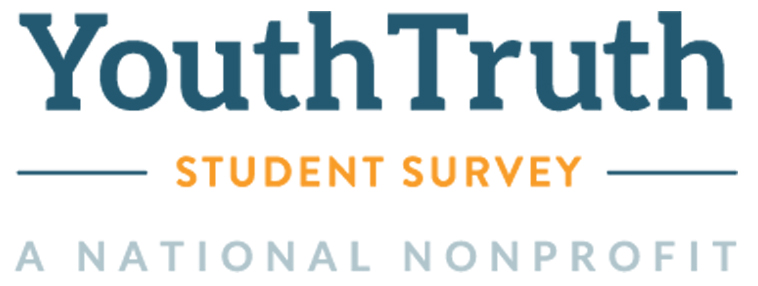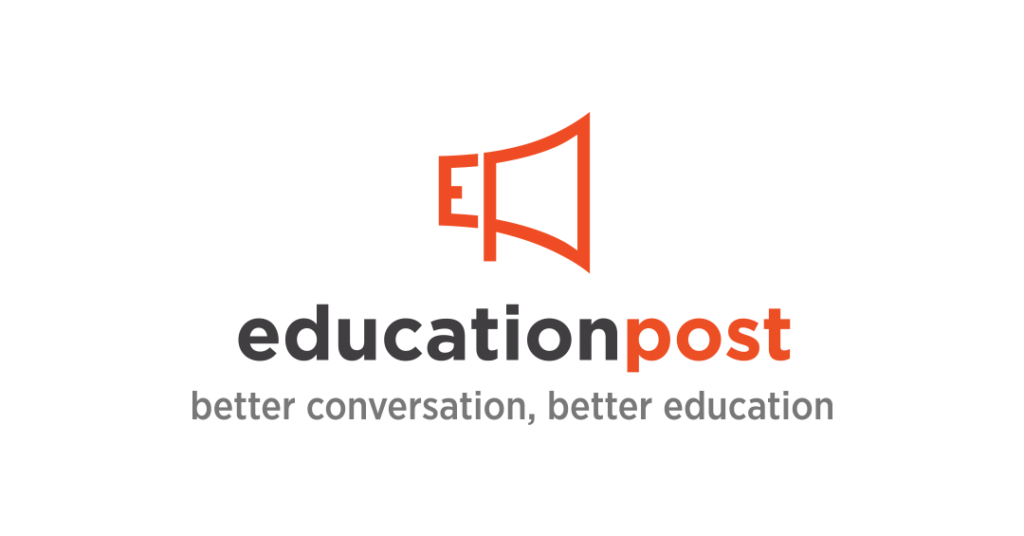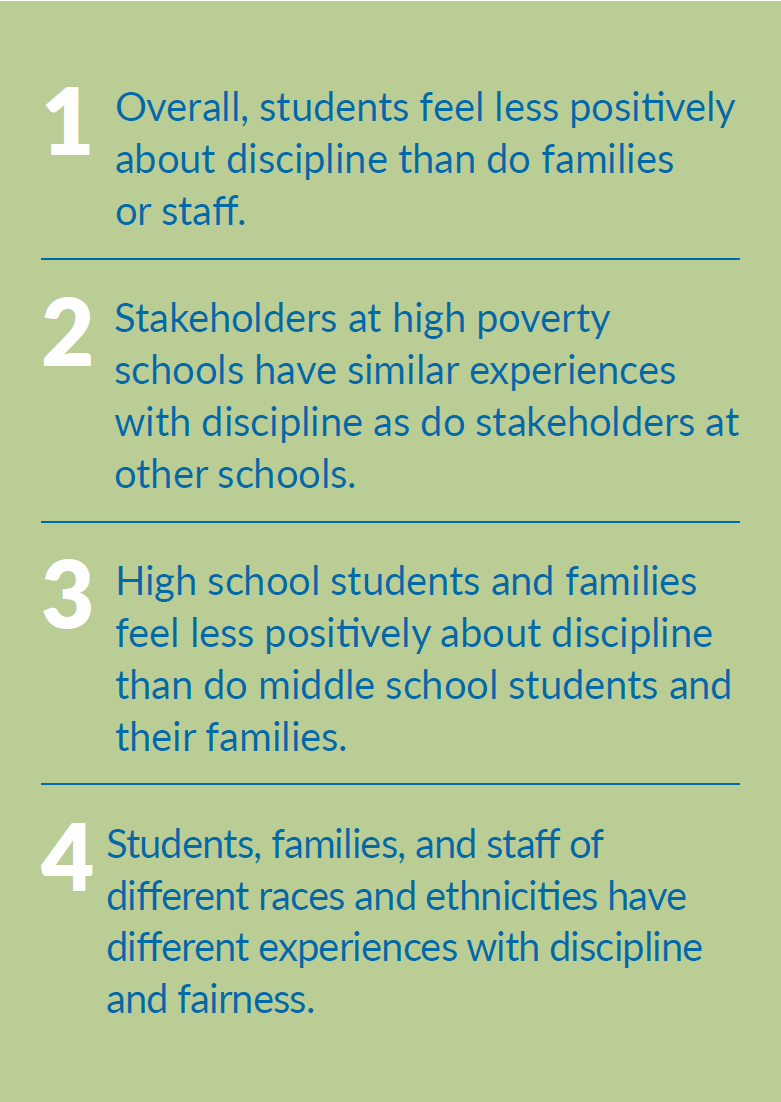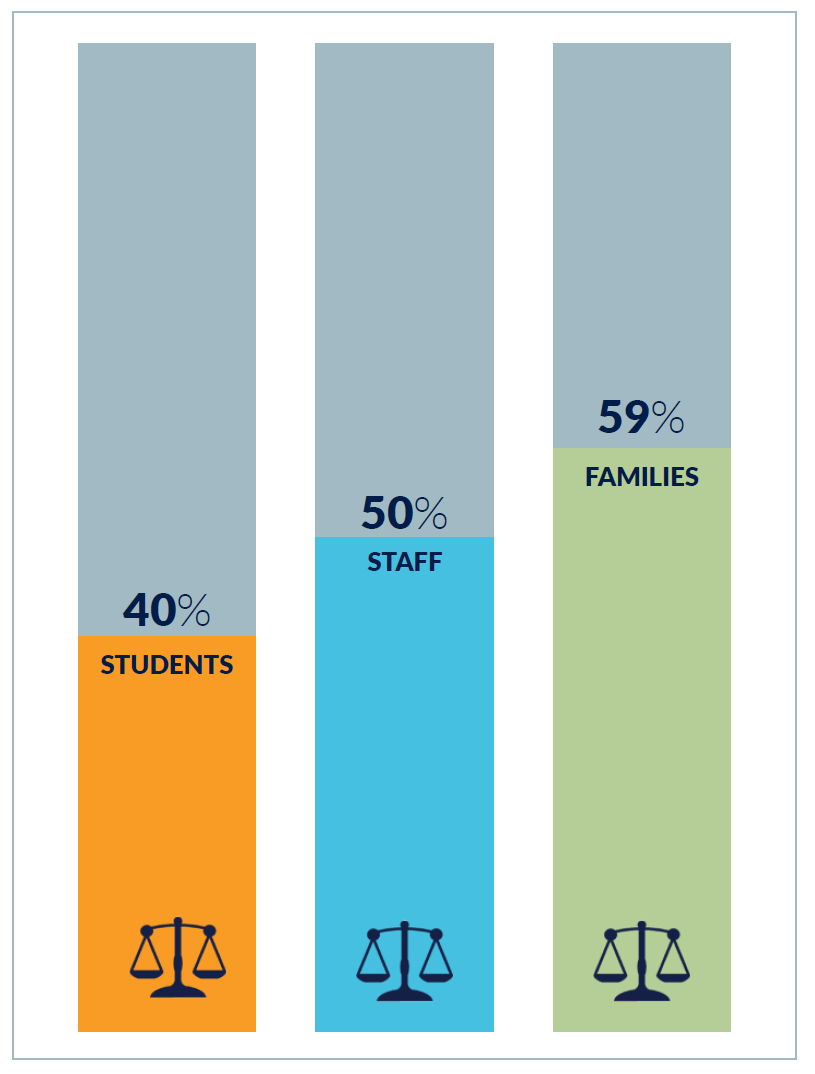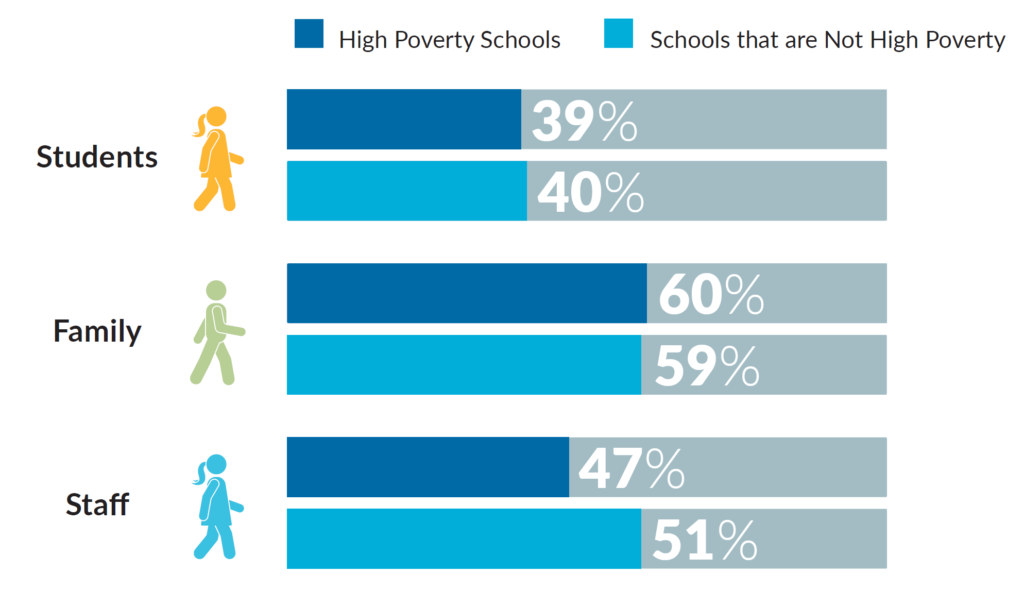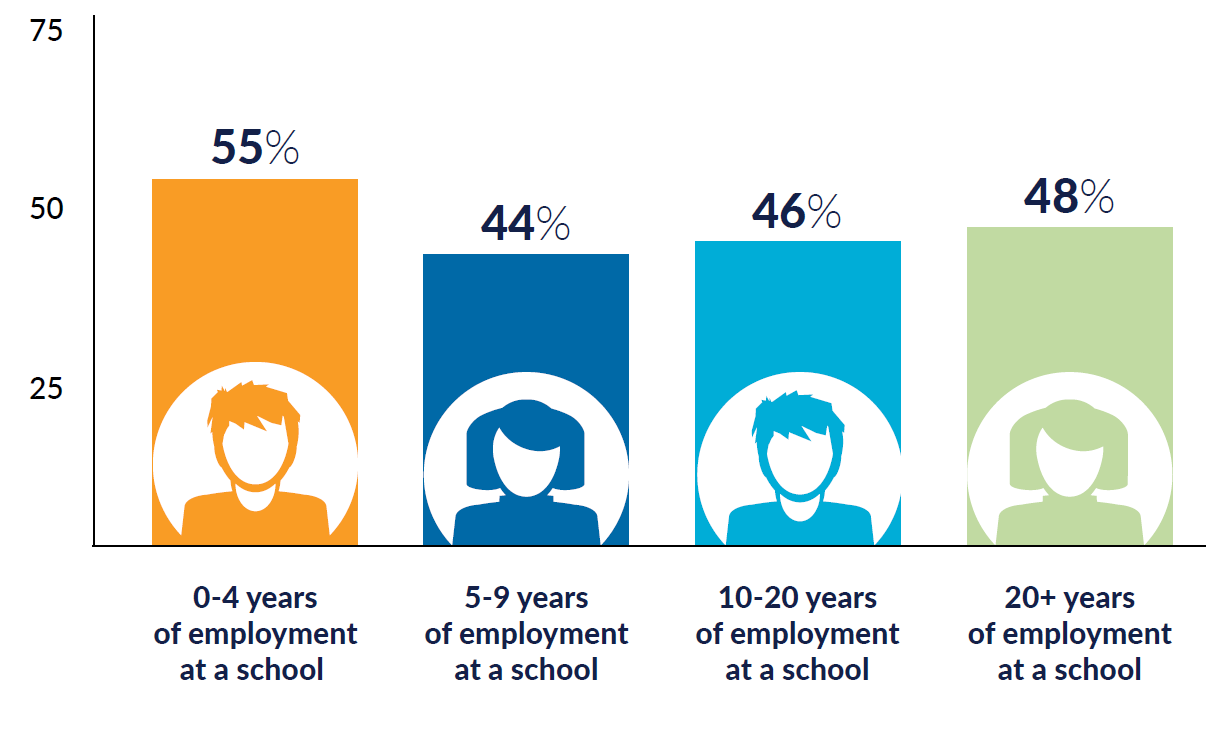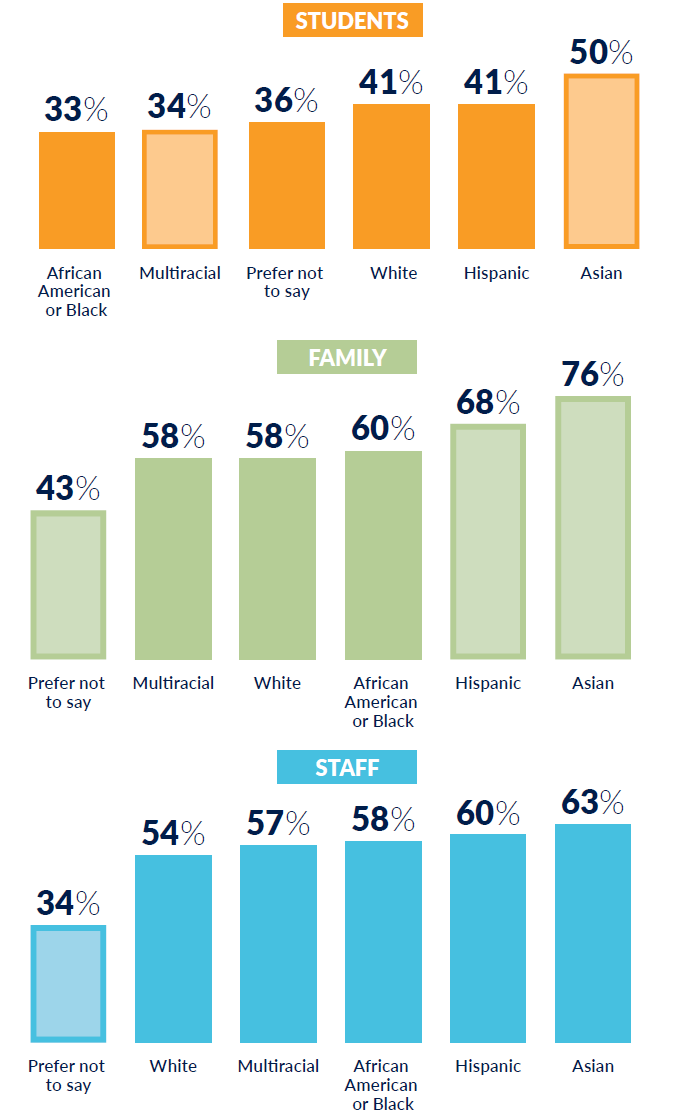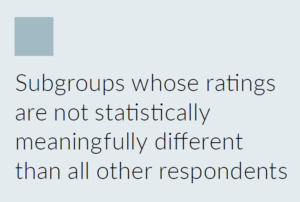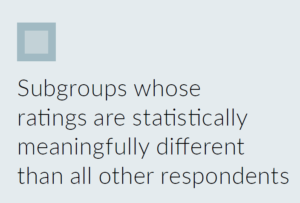Discipline and fairness are key aspects of a school’s culture.
A growing body of research shows that supportive, positive systems of discipline can radically improve social, emotional, and academic outcomes for students. Yet recent federal civil rights data suggest that discipline policies and protocols in U.S. schools are inconsistently administered and experienced across schools and populations. As a national nonprofit committed to elevating student and stakeholder voices on critical issues in education, we wanted to know: what do students, families, and staff think about discipline and fairness at their school? To answer this question, we analyzed survey data collected between fall 2016 and the end of 2018. We examined perceptions of discipline across over 104,000 secondary students, families, and school staff members and uncovered a number of insights.
Why explore discipline across students, families, and staff?
Student, family, and staff members’ experiences with discipline and fairness each play an important role in a school’s overall climate. We know that student perceptions are linked with outcomes, and we know that parent and guardian perceptions of school matter in school choice and enrollment, as well as a family’s connection to and investment in to school’s culture. Likewise, staff buy-in is a critical component in maintaining the positive systems of discipline that contribute to safe and welcoming learning environments. ![]()
1.
Overall, students feel less positively about discipline than do families or staff.
Discipline is a key aspect of culture and student success. Yet for educators, building and maintaining effective systems of discipline can feel like a balancing act between recognizing students’ unique circumstances and creating a safe and welcoming campus for everyone. When we look at how each group of stakeholders — students, families, and staff — rate the fairness of discipline at school, we see that students report the least positive perceptions. Less than half of students – 40 percent – feel discipline at their school is fair. Of the three groups, families feel most positively. Fifty-nine percent of parents and guardians feel that discipline at school is fair. Half of staff respondents – 50 percent – say the same. ![]()
![]()
![]()
“Discipline at my school is fair.”
Not all of the students in the school receive the fairness and respectful discipline. Students are not treated with the discipline that they should be treated with because rules, policies, and procedures that should be followed are not.
Sometimes it seems as though discipline policies are implemented but not followed through with. This makes it confusing for staff to know what to enforce, and how to do it.
2.
Stakeholders at high poverty schools have similar experiences with discipline as do those at other schools.
Poverty has an enormous impact on the physical and mental health and well-being of students, and we were curious to understand the relationship between a school’s poverty level and stakeholders’ experiences with discipline. We compared high poverty schools — schools in which at least 70 percent of students receive free or reduced-price lunch — with schools in which fewer than 70 percent of students receive free or reduced-price lunch. We did not find a meaningful difference in stakeholders’ perceptions across these two groups of schools. Thirty-nine percent of students attending high poverty schools rate school discipline positively, compared to 40 percent of students at other schools. Similarly, families and staff members of high poverty schools rate the fairness of school discipline only a few percentage points differently than those at other schools. The differences between student, family, and staff perceptions of discipline at schools that are high poverty versus schools that are not high poverty are not statistically significant.
LOW-INCOME STUDENT AND FAMILY PERCEPTIONS OF DISCIPLINE
When analyzing the data based on students’ free or reduced-price lunch eligibility, regardless of the overall poverty level of the school a student attends, we also see no significant difference.
3.
High school students and families feel less positively about discipline than do middle school students or families.
Middle school students rate school discipline ten percentage points more positively than do high school students. Similarly, 63 percent of middle school families rate the fairness of discipline positively while only 55 percent of high school family members say the same. However, there is no significant difference in the eyes of middle school versus high school staff members when it comes to how they perceive the fairness of discipline at their schools.
Discipline needs to be rethought and monitored more carefully. It seems that many students receive a slap on the wrist, while other students are dealt with more harshly for minor offenses. More counseling and guidance could be used for more minor infractions to guide students in the right direction.
TEACHER RETENTION AND SCHOOL DISCIPLINE
We know that increased teacher retention improves outcomes for students, and that some of the biggest reasons teachers leave are lack of voice and issues related to culture and, in particular, discipline. Teachers also tend to leave in the first 5 years. Staff perception of discipline and fairness decreases around the five-year mark of employment at a school. While our survey methodology does not address the answer to why staff feel less positively after working at a school for more than five years, this finding is an example of the nuanced insight that can be gleaned when we ask school staff about their experiences directly and the important conversations within schools such insights can spark. Read more about YouthTruth’s findings about teacher retention in this op-ed published in EducationWeek’s blog Next Gen in Action by YouthTruth’s Director of Partnerships and Outreach, Sonya Heisters.
4.
Students, families, and staff of different races and ethnicities have different experiences with discipline and fairness.
There is not one racial or ethnic group that has a consistently more or less positive experiences with school discipline across all stakeholders. However, our analysis reveals several differences within each stakeholder group. A closer look shows that Asian students rate discipline at their school more positively than do other racial or ethnic groups, while multiracial students rate discipline at their school less positively. (African American or Black students’ ratings are a few percentage points lower than other students’ ratings, but the difference observed in our sample was not statistically meaningful.)
Hispanic and Asian parents and guardians also rate school discipline somewhat more positively than other racial or ethnic groups, while white family members and those who preferred not to identify their race or ethnicity rate less positively. School staff who preferred not to say their race or ethnicity also feel less positively about school discipline.
STAKEHOLDER AGREEMENT

In YouthTruth’s analysis, if one group of school stakeholders feel positively about discipline, other stakeholder groups in that school tend to agree. Of the “top performing” schools in the eyes of students (that is, the top 25 percent of schools in our sample based on student ratings of discipline), 69 percent are “above typical” in the eyes of parents and guardians (that is, in the top half of schools in our sample based on family members’ ratings of discipline). Likewise, of top performing schools in the eyes of students, 75 percent also receive above typical ratings by staff. ![]()
![]()
Measuring School Discipline and Fairness
Discipline policies influence a school’s climate and culture, and when designed and implemented well, help a school run smoothly, support teachers, and set up equitable conditions of learning. Since student perceptions are leading indicators, anonymous and real-time feedback about perceptions of discipline today can help educators adjust now to create a better tomorrow. When managed poorly, however, school discipline policies and practices can have serious long and short term effects not only on student learning, but also on students’ lives inside and outside school, including contributing to the school to prison pipeline. Triangulating perceptions and experiences of school discipline across stakeholder groups can help educators discover what aspects of discipline practices and policies are truly working, and for whom. Positive discipline practices help students, families, and staff to develop mutually respectful relationships, reduce disciplinary action, and improve classroom environment. ![]()
![]()
Positive practices of discipline — including programs like Positive Discipline — are kind and firm, geared toward long-term effectiveness, and help students feel a sense of belonging and significance. Progressive discipline practices invite students to discover how capable they are and use their personal power in constructive ways.
The only way to fully understand whether a school’s culture is healthy and supportive of learning and achievement is to ask stakeholders in schools directly about their perceptions and experiences. We hope these findings will embolden educators to prioritize closing the gap in how students, families, and staff perceive and experience discipline.
Want to learn more about you can gather student feedback to drive improvements in your school or district?
Take Action
RESOURCES
- American Federation of Teachers – Resources on Positive School Discipline The AFT has developed a number of resources to help educators implement positive discipline strategies.
- Center for Parent Information & Resources – School Discipline CPIR provides materials to read and share on school discipline for parents and educators.
- National Association of School Psychologists – Behavior & Discipline The NASP Center offers behavior and discipline focused guides, fact sheets, and resources for youth.
- The National Center on Safe Supportive Learning Environments NCSSLE offers information and technical assistance to States, districts, schools, institutions of higher learning, and communities focused on improving student supports and academic enrichment.
- National Clearinghouse on Supportive School Discipline NCSSD provides educational practitioners with the resources needed to facilitate the reduction of harsh and exclusionary discipline practices to stem the pipeline to prison and the implementation of supportive school discipline practices.
- National Education Association On this NEA web-page, find approaches to solving a multitude of challenges relating to discipline in schools.
- Positive Behavioral Interventions & Supports PBIS provides numerous training, research, and evaluation resources for schools, families, and communities focused on school wide discipline based on supporting appropriate student behavior to create positive school environments.
- Positive Discipline Positive Discipline teaches important social and life skills in a manner that is deeply respectful and encouraging for both children and adults.
- PromotePrevent – Positive School Discipline PromotePrevent provides resources for implementing Positive School Discipline.
- U.S. Department of Education – School Climate and Discipline Tools, data and resources focused on school climate and discipline are available on this site.
Closing the Feedback Loop: Sample Discussion Questions
- Do you think these findings speak to the experiences of students, families, or staff at your school? Which data points seem most reflective of your school’s culture?
- How do you think students’ perception of culture on your campus might be similar to or different from these findings?
- What sources inform your hypothesis?
- When and how will you engage students in reflecting on this data with school leadership teams? What questions do you have after reflecting on this data?
- When you compare the experiences of discipline across stakeholder groups at your school, what do you notice? Do you see any differences in perceptions of discipline across racial or ethnic groups? Which data points seem most relevant?
- What is one thing your school could try this year to improve school discipline?
- What is one thing your school could try this year to improve school discipline?
- In your opinion, what does positive behavior and positive decision making look like in school? Can you share an example that you’ve seen at your school of someone promoting positive practices of discipline?
- What strategies and resources are available if you see a student affected by unfair discipline policies or practices?
DOWNLOAD THE FULL REPORT
To help educators, parents, education funders, and students grapple with the landscape of school discipline in U.S. schools, we went straight to the source for more insight. We asked over 104,000 students, family members, and staff members about their experiences with discipline between fall of 2016 and the end of 2018. Download the full report to:
- Understand how student, family, and staff experiences with discipline are similar or different along themes like race, family income, a school’s poverty level, and a school’s grade range
- Discover resources to take action
- Close the feedback loop with suggested discussion questions for principals, teachers, and professional learning communities as well as for teachers and principals in conversation with students
